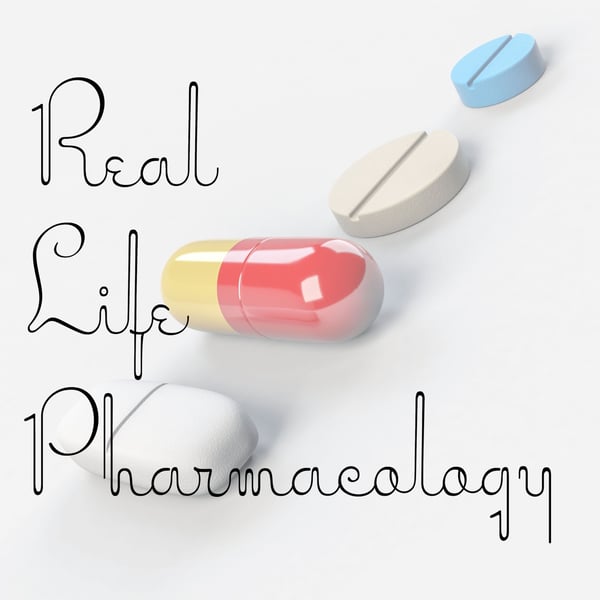Top 200 Drugs – Medications 51-55
Real Life Pharmacology - Pharmacology Education for Health Care Professionals
Eric Christianson, PharmD; Pharmacology Expert and Clinical Pharmacist
5 • 716 Ratings
🗓️ 15 August 2024
⏱️ 17 minutes
🧾️ Download transcript
Summary
Eszopiclone is a "Z" drug used for insomnia. Its adverse effect profile is very similar to benzodiazepines.
Celecoxib is a COX-2 Inhibitor used for pain and inflammation. I discuss how this medication differs from traditional NSAIDs.
Estrogen therapy is used for menopausal symptoms but carries a risk of cancer and blood clots.
Moxifloxacin is a quinolone antibiotic. Binding drug interactions, boxed warnings, and QTc prolongation are potential concerns.
Donepezil is a medication used for dementia. I discuss its mechanism of action and common adverse effects.
Transcript
Click on a timestamp to play from that location
| 0:00.0 | All right, so getting into the medications today, drug at number 51, the brand name is Lunesta. |
| 0:07.5 | Generic name is Azopaclone. |
| 0:11.6 | Its mechanism of action is it binds to and potentiates the effect of gamma receptors leading to a sedative type effect. |
| 0:20.2 | So, as you can imagine, this medication is |
| 0:22.9 | classified as a sleeper or a sedative type agent. Again, falls under the classification of a |
| 0:31.9 | Z drug because the generic name has a Z in it and it's for sleep. So that's a good kind of classification to remember if you're being tested on that. |
| 0:41.4 | And mechanistically, it works very similar to benzodiazepines. |
| 0:47.1 | So as you could expect, we are going to have a very, very similar adverse effect profile. |
| 0:54.9 | So dizziness, confusion, obviously sedation, that's generally what we're trying to do there. |
| 1:02.8 | Increased risk for falls, particularly in the elderly. |
| 1:07.2 | Also, you know, associated with most of the sleeping medications, we can have some rare sleep-type |
| 1:14.4 | side effects. |
| 1:15.1 | And the Z-drugs are specifically notorious for this. |
| 1:18.9 | Sleep-walking, sleep-eating, kind of these unique and abnormal sleeping-type behaviors. |
| 1:27.5 | In addition to that, vivid or bad dreams are possible. |
| 1:32.6 | This is definitely something I've heard patients report. |
| 1:36.9 | There is a risk of addiction and dependence with these agents. |
| 1:41.4 | So they are a controlled substance and they are scheduled for there. |
| 1:46.8 | So with Lunesta specifically, I keep an eye out for patients who are using this long term. |
| 1:55.6 | Obviously, like to try to get them off of a controlled substance long term, if at all possible. |
| 2:02.3 | Do your best limit dose, so minimize that risk for falls and confusion and other kind of |
| 2:08.6 | collateral damage. And then, of course, making sure that we're tapering periodically or |
... |
Transcript will be available on the free plan in -225 days. Upgrade to see the full transcript now.
Disclaimer: The podcast and artwork embedded on this page are from Eric Christianson, PharmD; Pharmacology Expert and Clinical Pharmacist, and are the property of its owner and not affiliated with or endorsed by Tapesearch.
Generated transcripts are the property of Eric Christianson, PharmD; Pharmacology Expert and Clinical Pharmacist and are distributed freely under the Fair Use doctrine. Transcripts generated by Tapesearch are not guaranteed to be accurate.
Copyright © Tapesearch 2025.

